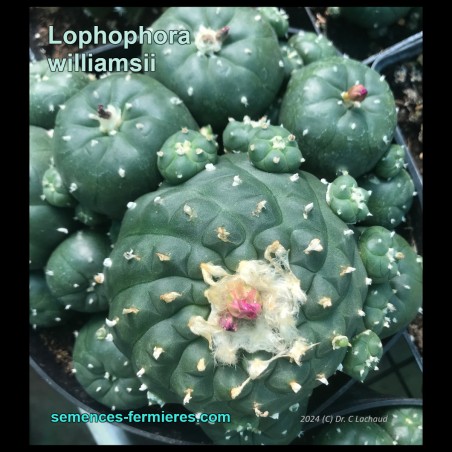













Lophophora williamsii - Peyotl
1 packet of 10 seeds
-
Lophophora williamsii is a small Cactus belonging to a genus of 4 species
It is native to the arid regions of Mexico and the South of the United States, where it has become rare due to untimely collection from the natural environment
It is listed in the Red Book of Threatened Species under Vulnerable status
Most of Peyotl's body is buried underground as a protection from the sun
The aerial part or crown is globose, fleshy but tough, non-thorny, glaucous green, and protrudes little above ground level

When in favorable growing conditions, Peyote produces numerous offshoots
It thus ends up establishing a more or less dense colony of Peyotes
Lophophora williamsii makes quite pretty flowers, more or less pink depending on the subspecies and inter-individual variations
They bloom in the center of the crown, one to three simultaneously, and sequentially from spring to the end of summer (if favorable conditions)
Each flower lasts a few days, opening to the sun and closing in the evening
Remarkable characteristic: Its stamens are sensitive to contact (for example during the visit of an insect) and will retract downwards so as to limit the chance of self-pollination
A flower is followed by a small bright pink fruit, which only pops out when ripe
The Peyote fruit contains a few black seeds as big as a pinhead
Germination is quite easy
Peyote contains psychoactive alkaloids such as mescaline
For this reason, it is traditionally used as a powerful entheogen in initiation rituals and shamanism, to help breaking the waking state of consciousness, access the spirit world, and encounter Mescalito
WARNING
Eating Peyote is prohibited in France and other European countries
In addition to its alkaloids' toxicity, Peyote induces trances that are risky outside the initiatory framework provided by a Shaman or Spiritual guide
They can irremediably lead to psychosis
-
Sow Peyote seeds in spring, on moist, non-calcareous sand
Keep the substrate moist and expose to sunlight and lukewarm
Under these conditions, germination occurs quickly, within a few days
When the seedling is large enough to be handled, transplant into separate pots filled with a mixture of garden soil and potting soil
Grow by providing sun, heat, fertilizer, and water until the end of summer
Then, reduce watering and set a dry regime from October up to spring (in a heated apartment, leave the soil to dry completely for a couple of days before the next watering)
In spring, unpot and remove the old soil from the roots, then repot in new soil mix, and start the growing cycle again
Within 3 years of such care, your Peyotes will already reach a nice size and some may even start to flower
Lophophora williamsii is a very tough cactus, little demanding, and very easy to grow
It is perfectly resistant to lack of watering, but if you want it to thrive, give it the combination of heat+sun+water+fertilizer in spring and summer
You might also like
Payment :
PayPal < 150 €
Check < 850 €
Bank Wire > 149 €
Thank you for your kind understanding